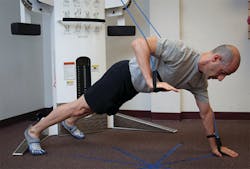Tactical Fitness: Do This, Not That
I do not have time to exercise; I am too tired from my shift; my back is too sore to work out; the list is endless. How many times have you seen an officer join the force fit and eager and within a few years they are out of shape and stressed out.
While teaching a tactical fitness class a few weeks ago I was amazed at the lack of conviction the training officers had. Not in their dedication to fitness and injury prevention but in the follow through and dedication of their peers to stay the course. While teaching these officers and operators how to improve physical performance through corrective exercises we stumbled into a discussion about good versus dangerous exercises. I specifically recall one participant getting frustrated as I essentially told him that almost every exercise he did was not in his best interest. This discussion rapidly led into a do this - not that training session which we all enjoyed, so let’s take a look at some of the exercises we dissected.
As I have discussed at length in this column MANY times the first exercise we suggest doing less or never is the abdominal crunch. Instead of the crunch we prefer exercises that stiffen the spine and brace the abdominal wall as these vastly improve performance, power and stability in the torso, spine and core. The abdominal exercises here are fantastic as they force you to use every muscle in your body and this will help boost anaerobic capacity or short burst ability. The key to these exercises is simple.
1) Feet must be straight at all times with the legs hip width apart.
2) You must squeeze your glutes with each rep, imagine holding a gold coin between your cheeks.
3) Your hips must remain flat at all times, no rocking side to side. Imagine a carton of eggs on your lower back.
4) Your spine needs to be neutral at all times, so a broom stick on the back in contact with your head-mid-back and lower back will do the trick.
5) Control is the key here so the repetitions are not important, the technique is. If your glutes are tight, spine neutral, feet straight and still and your speed is constant trust me your abs will quickly let you know that they are working hard.
As a side note all these moves can be combined with a push up movement to increase the intensity and the difficulty. Perform this type of training one to two days per week at the end of your workout. Training abs first is a fitness myth, we do not want the abs fatigued early and then ask them to help give torso/spine stiffness through a workout. Training abs last or toward the end of a workout makes a lot more sense and means that you have to do a lot less abdominal work as they are already fatigued from the workout. Next month we will look at back extensions.
Web Links:
About The Author:
Bryan Fass is the author of “Fit Responder”, a comprehensive wellness plan for the first responder, and the Fit Responder Blog. Bryan has a Bachelor’s Degree in Sports Medicine and is certified as a licensed athletic trainer and a strength and conditioning specialist. He was a paramedic for over 8 years. Bryan has authored four books regarding fitness, wellness and human performance. Bryan is available for Consulting and Speaking on Public Safety Fitness Testing along with Fitness, Wellness and Injury Prevention Programs. Contact him via email to [email protected].

Bryan Fass
is a leading expert on public safety injury prevention. As the president and founder of Fit Responder Bryan’s company works nationally with departments, corporations; state and local governments to design and run targeted injury prevention and wellness programs. He is frequently contacted for expert opinion and content contribution for all aspects of public safety fitness, ergonomics and wellness. Bryan authored the Fit Responder book used by departments and schools plus writes for numerous web and peer-reviewed journals including the NSCA-Tactical Strength & Conditioning journal, officer.com, ems-1.com & best practices in EMS. Bryan holds a bachelors’ degree in sports medicine with over 17 years of clinical practice, was a paramedic for over 8 years, and is certified as an Athletic Trainer (ATC, LAT), Strength Coach (CSCS) and the Functional Movement Screen (FMS). Fit Responder developed the nation’s first validated pre-hire Physical Abilities Test for EMS. Bryan is a sought-after speaker on a variety of topics including risk reduction, employee self-care, real world wellness and How to Eat on the street. www.fitresponder.com
Every Lift Counts!



